|
< Earlier Kibitzing · PAGE 49 OF 49 ·
Later Kibitzing> |
| Oct-07-10 | | visayanbraindoctor: PART 13
GAME MOVE 26:
<26…f5> ( 1.50)

click for larger viewRogers: <”A second bid for counterplay. 26...Nc5 27.Kd1 Nxd3 28.exd3! (Not 28.Kxc2?? Ne1+) 28...Rc8 gives Black a great knight on d5 but after 29.f3! and 30.Rc2, the position must be a slow but sure win for White.”> Polgar: <”White has a few reasonable responses. 26.Kd1, 26.gxf5 or 26.Rg1. White is better in all three lines.”> Illescas-Cordoba: <”Kramnik finds the most stubborn defence. White has problems to get his rook into play.”> Black’s move 26 is a blunder as it produces a lost position (evaluation >1.40). Because none of the analysts, three of whom are GMs, spotted this as an error, let alone as a losing move (one even gave it an !), this analyst spent considerable amount of time investigating the length and depth of many variations that spring from this move, to reassure himself that the evaluation validly expressed a lost game for Black. Some of the analysis is in later posts in this series, but it is a deeply complex and subtle endgame, requiring enormous patience to prosecute; and the analysis is by no means complete. There are numerous subvariations where the slightest mistake can cancel the winning advantage, and moreover with branching subvariations at many, sometimes successive, moves of almost equal value. There are quite a few variations with moves that can only be described as machine moves, that humans probably wouldn’t think of playing, eg: setting up the capture of a central pawn in the endgame, and having achieved that capacity then resists capturing to support other advances on the board. The analysis has been saved and is accessible to the curious and/or the masochistic. It’s worth noting that the >1.40 evaluation for this move did not emerge until after considerable engine time and frequently goosed analysis; it was necessitated by the need to spend additional time ironing out inconsistencies in the engine’s evaluations of the moves in this part of the game. <Main engine preference>: <26...Nc5> (±1.26): <27.Kd1 Nxd3 28. exd3>: 
click for larger viewOnce the rook retreats, Black’s position is very difficult and maybe even indefensible, as Rogers pointed out. White’s rook swings over to c2 and Black has to concede the c-file or face a lost B vs N ending. The penetration of the rook combined with the King and Bishop to shepherd the queen side pawn majority will make Black’s life miserable. After extensive testing of many variations, there appears to be no forced win. Most variations do in fact end in a win for White, indicating that in practical play White would usually win, as Black has to be excruciatingly accurate to survive this sort of ending. On careful examination of the critical moves, this analyst has always found a saving resource for Black, and comes to the conclusion on the balance of probabilities that there is no forced win for White in the position starting from <26…Nc5>. It is understandable that Kramnik avoided this variation for a wilder bid for freedom (26…f5), and in its own way the latter move pays off as Anand lets him off the hook in subsequent play. Accordingly, the exclamation mark awarded by GM Illescas for Black’s 26th move is deserved as it describes Black’s best practical bid for freedom, but under the cold hard pitiless and <unhuman> scrutiny of the machine, it constitutes a blunder as it must lose if White conducts the response perfectly. <The blunder <<26…f5>> adds <<2.0>> to the game’s error weighting.> |
|
| Oct-07-10 | | visayanbraindoctor: PART 14
GAME MOVES 27-28:
<27. Kd1> ( 1.50) <27…Rc8> ( 1.52) <28. f3> ( 1.52) <28…Nd6> ( 1.52) Polgar: <”White is still working on getting his Rook active. If he is able to do that, he will have good chances to score a full point. It is obviously not a simple task.”> GAME MOVE 29:
<29. Ke1> ( 1.09)
Polgar: <”An unusual move in this position but it does not do any harm to his position. 29.Rg1 is more logical to me.”> Pein: <”Karpov advocated Rg1 as a better way to avoid any knight forks but this is also good. Vishy takes it nice and slowly.”> Rogers: <”?!”>
<29. Rg1> is indeed a better choice ( 1.29), however only <29. e3> opening the second rank to the rook to enable access to the c-file actually maintains the win. As foreshadowed after Black’s blunder with <26…f5>, the endgame is obscure and difficult, and took extensive verification of numerous variations to confirm that the engine’s assessment of the position since Black’s 26th move is indeed correct, and not a machine aberration or symptomatic of endgame ineptness by the engine. The <main variation> proceeds as follows: MAIN VARIATION MOVE 29:
<29. e3>:

click for larger viewClearing the second rank, ready to oppose and exchange rooks on the c-file. MAIN VARIATION MOVE 29:
<29…fxg4>
Black could also try <29…Nc4>, but to little avail, eg: <30. Re2 (…31. e4 with greater effect than in the main variation because of the presence of Black’s f-pawn) 30…Rd8 31. Kc2 Rc8 32. Kb3 Na5+ 33. Ka2> and now if: (a) <33…Nc6 34. e4 Nd4 35. Rf2 Nb6 36. Be3 Nc2 37. Bxb6 axb6 38. Ne5 threatening 39. Rd2> wins (b) <33…Rc3 34. Rd2> and after the Black rook moves, White will exchange pawns on f5 and follow with e4 and/or Ne5 with a winning bind. (c) <33…fxg4 34. hxg4> threatening e4 and f4 wins, eg: <34…Nc6 35. e4 Nde7 36. Rc2> with a routine win. MAIN VARIATION MOVE 30:
<30. fxg4>:

click for larger viewIf <29. hxg4>, then <29…Nc4 30. Re2 Rf8 31. f4 (31. Ne1 is passive) 31…Rd8 32. Kc2 Rc8 33. Kb3> is similar to the main variation being developed here, but after <33…Nf6>, the unprotected g-pawn needs to be protected with the rook, diverting it from its mission on the c-file, or the pawn has to advance to <34. g5> after which Black has <34…Ne4>: 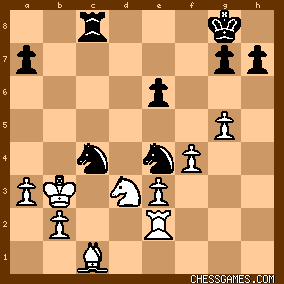
click for larger viewthreatening <35…h6> with sufficient counter play in light of White’s passive bishop and underused rook, and his own active pieces and solid defensive formation to be hopeful of securing a draw and neutralizing the queen side pawn majority, eg: if <35. Rg2 g6 36. Ka2 Na5> holds the line. |
|
| Oct-07-10 | | visayanbraindoctor: PART 15
MAIN VARIATION MOVES 30-31:
<30…Nc4 31. Re2>:
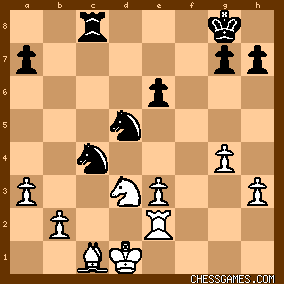
click for larger view<31. Ke2> blocks the rook, and <31. Rg3> consigns the rook to passive guard duty. The text threatens <32. e4> followed by <32. Rc2> to great effect. MAIN VARIATION MOVES 31-34:
<31…Rd8> (threatening <31…Ndxe3+ and 31. Ne5>) <32. Kc2> (still threatening <33. e4> and also <33. b4>) <32…Rc8 33. Kb3> (again threatening <34. e4>) <33…Na5+ 34. Ka2> (threatens both <35. e4> and <35. Bd2>) <34…Rc3>:
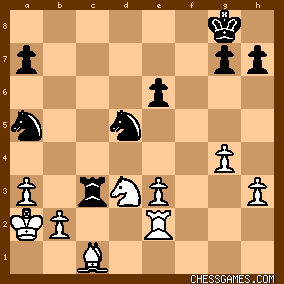
click for larger viewThis spectacular move temporarily meets both threats as <35. e4> would dissipate White’s win after the exchanges: <35…Rxd3 36. exd5 exd5>. More important than the temporary concession of a pawn, this exchange would allow Black’s rook to be active behind White’s lines. MAIN VARIATION MOVE 35:
<35. Re2>
The only move, but sufficient to maintain winning momentum. Black can only buy time, not salvation. MAIN VARIATION MOVE 35:
<35…Rc8 36. Rh2 (threatening 37. e4) and White has a smorgasbord of choices from each of Black’s most viable replies, including <36…Nb6>, <36…Nf6>, <36…a6>, <36…Rc7>, <36…Nb7> and <36…Rc4>. White’s basic strategy will be to use his pieces to maximize his extra pawn and to shepherd his queen side majority forward, gradually tying down Black’s defenses, and forcing the extra pawn through with decisive effect. The shortcoming of <26…f5> to the alternative defence <26…Nc5> that was discussed previously is that with <26…Nc5>, Black can set up a defensive formation on the King side, typically consisting of pawns on g5, f6 and e6, and possibly also h6 depending upon whether h-pawns have been exchanged, with a Night on d5 and the rook on the second rank, whereas those defensive (and extremely tedious and difficult) possibilities are not available in this variation. Some of the subvariations that emanate from Black’s 36th move have been explored, but have not been included here for space considerations. Anyone interested is invited to explore those subvariations themselves and compare notes with my own findings. CONCLUSION: <As <<29. Ke1>> brings the evaluation well below 1.41 , it constitutes a blunder and adds a further <<2.0>> to the games error weighting.> |
|
| Oct-07-10 | | visayanbraindoctor: PART 16
GAME MOVE 29:
<29…a5> ( 1.09)
Illescas-Cordoba: <”Maybe it was better to insist on 29...Rc2!? Here is a sample line: 30.Rf2 Ne4!? 31.fe4 fe4 32.Bg5! ( 32.e3?! Rc8 ) 32...h6! 33.Bh4 ed3 34.ed3 Rc1 35.Kd2 Rh1 and white is better but black gets some counterplay.”> NOTE: <29…Rc2> would lose to <30. Kd1> chasing the rook away as after <31. e3> it would transpose to the main variation discussed previously. <29…a5> seems to be Black’s best move. GAME MOVE 30:
<30. e3> ( 1.14)
Not as useful now as the rook cannot contest the c-file, and the King is offside…it should be at a2 or a4 supporting the advance of its quite side pawn majority. <Engine preferences>: 1. <30.Rg1> ( 1.09): <30…a4 31.Kf2 Nc4 32.gxf5 exf5 33. e4 fxe4 34. fxe4 Nf6 35. Kf3 Nd7> is solidly defensive, eg: <36. Bf4 Nc5> or <36. Rg5 Rf8+>. 2. < 30.gxf5> ( 1.07) <30…exf5 31.Bh6 g6 32.Kf2 a4 33.Rg1 Nc4> and having stymied White’s queen side majority, Black has active pieces and enough counter play to survive. If now <34. Rc1> then <34…Ndb6> holds, GAME MOVE 30:
<30…e5> ( 1.26)
Threatening 31…e4.
Polgar: <”This is dangerous as Black is about to sacrifice another pawn. 30...a5 is safer for Black.”> Illescas-Cordoba: <”!? Again black finds the way to complicate the game but Vishy kept cool.”> Pein: <”With Kd1 and Rc2 coming Kramnik seeks activity but with less time on the clock to calculate this also backfires.”> Rogers: <”!?”>
<Main engine preference>: <30…a4> ( 1.08), eg: if <31. Re2 (threatening 31. gxf5 followed by 32. e4) 31…Nc4 32. e4 fxe4 33. Rxe4 e5 34. Bg5 Ndb6 35. Be7 Nd5 36. Nxe5 Nxb2 37. Bd6 Rd8 Re2 Nd1>: 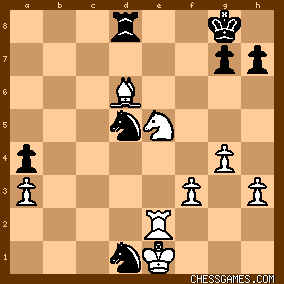
click for larger viewWhite has the pawn, but Black has it corralled and has plenty of piece activity; with careful footwork, he should be able to secure a draw. GAME MOVE 31:
<31. gxf5> ( 1.26) <31…e4>( 1.26) Rogers: <”!”>
The logical follow up to the previous move. If <31…Nxf5 32. e4 Nh4 33. Rg3 Nb6 (intending 34…a4) 34. Bg5 Ng6 35. h4 Nd7 (protecting e5) 36. h5 Nh8 (36…Ngf8 37. Bh6> wins a pawn and wins by force)>: 
click for larger viewAnd Black is getting pushed off the board, eg: <37.Bh6 g6 38.Bd2 a4 39.Bc3 Re8 40.Rg1> and Black will be cracked like a walnut as he is virtually in zugzwang. |
|
| Oct-07-10 | | visayanbraindoctor: PART 17
GAME MOVES 32-33:
<32. fxe4> ( 1.26) <32…Nxe4> ( 1.26) <33. Bd2> ( 1.26)
GAME MOVE 33:
<33…a4> ( 1.90)
Polgar: <” White can slowly unlock his position and capitalize on the material advantage with 34.Nf2 Nd6 35.Ke2 . Even though it is not an easy task, White has chances to win this endgame.”> Rogers: <” Kramnik targeted this move as his decisive error, "although of course the position is not pleasant."This is something of an understatement - perhaps only 33...Re8 sets up some tricks, hoping for 34.Bxa5? Nxe3! when Black is back in the game.”> Pein: <”33...Rc2 34.Kd1?? Nxe3+; but 33...Rc2 34.Re2 Nxd2 35.Kd1 Nxe3+ 36.Rxe3 Nc4 37.Kxc2 Nxe3+ 38.Kb3 Nxf5 39.Ka4 is easy; 33...Re8 was better.”> Illescas-Cordoba: <” Kramnik pointed this move as the final mistake at the press conference. Probably he was right. [ Black could get more drawing chances with 33...Rc2!? ; or 33...Re8!? while admitting white is still clearly better.]”> The losing move…Black’s game is lost after this and remains that way. <33…Re8> ( 1.26) was necessary: If <33...Re8>, the engine recommends <34.Nf4 Nxf4 35.exf4>: 
click for larger viewThe discovered check isn’t dangerous. White threatens <36. Bxa5 and 36. Re2>. <35…Nxd2+ 36.Kxd2>:

click for larger viewDespite the two extra pawns, White does not have a win, eg: <35…Kf7 37. Re2 (37. Kd3 is an alternative, but not 37. Kc3? Re3+) Rb8 38. Kc3 Kf6 39. Re6+ (White has to give up the f-pawns so he can capture the a-pawn, because if Black can slip the a4 move in, he has a draw – an alternative is 39. Re4 preventing 39…a4, but this is also defensible for Black) 37…Kxf5 38. Re5+ Kxf4 39. Rxa5>: 
click for larger viewWith a likely draw.
Another alternative to <39. Re5+> is <39. b4>: 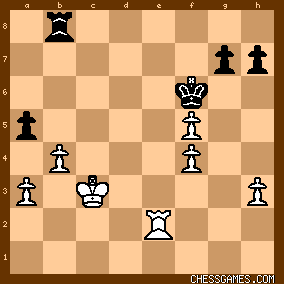
click for larger viewIf <39…axb5>, then <40. axb5 Kxf5> with a likely draw. <Black’s <<33…a4>> is a blunder for the purposes of this project as it crosses the 1.40 boundary to 1.90 to a lost game. This therefore adds 2.0 to the game’s error weighting.> |
|
| Oct-07-10 | | visayanbraindoctor: PART 18
GAME MOVE 34:
<34. Nf2> ( 1.90)
Illescas-Cordoba: <”! After this move white gets the coordination he was lacking.” Pein: <” ! The computer assessment jumped as Anand stays two pawns up.”> Rogers: <”!”
GAME MOVE 34:
<34…Nd6> ( 2.03)
Polgar: <” Kramnik and his team must be scratching their heads. He is being outplayed in complicated positions which typically favor Anand and he is also being outplayed by Anand in a dull and quiet position which supposed to favor Kramnik. They have to figure things out quickly as we are at the half way point of this very short match.”> The <engine preference> is <34...Nxf2>, but only by a small margin. Black is lost GAME MOVE 35:
<35. Rg4> ( 1.65)
<Engine preference> is <35.Ke2>, but this makes no difference as again the margin of differences is small. The move played by White clearly wins. GAME MOVE 35:
<35…Nc4> ( 2.32)
Polgar: <” Kramnik chose not to win back one pawn with Nxf5. He instead chose to go after the b2 pawn. 36.Nd1 would give White a serious advantage.”> Illescas-Cordoba: <” [ After 35...Nf5 36.Ra4 Nde3 37.Be3 Ne3 it would be a matter of technique ]> The <engine preference> follows GM Illescas-Coredoba: <35...Nxf5 36.Rxa4 Ndxe3 37.Bxe3 Nxe3>. However, as he points out it is a matter of technique. GAME MOVE 36:
<36. e4> ( 1.90)
Illescas-Cordoba: <”[ Why not a simple retreat? After 36.Nd1! Anand told me that he was worried with the blockade of the black knights but to my view after Kf7 37.Rd4 Ndb6 38.Bc3 white is simply two pawns up. ]”> <Engine preference> is also <36.Nd1> (2.32 ) GAME MOVE 36-37:
<36…Nf6> ( 2.20)
<37. Rg3> ( 1.90)
<Main engine preference> is <37. Rg5> ( 2.20). |
|
| Oct-07-10 | | visayanbraindoctor: PART 19
GAME MOVE 37:
<37…Nxb2> ( 2.63)
Illescas-Cordoba: <” Takes one pawn back but the position is still lost. [After 37...Ne4 there is a forced variation: 38.Ne4 Re8 39.Bc3 Re4 40.Kf2! Ne5 41.Re3! Re3 42.Ke3 and white is easily winning here ]”> Polgar: <” I think a better move is 37..Nxe4 38.Nxe4 Re8”> <Main engine preference>: < 1.90: 37...Nxe4 38.Nxe4 > GAME MOVE 38:
<38. e5> ( 2.63). Crushing. Rogers: <” 38.Bc3 Nh5 is not so clear.”> Illescas-Cordoba: <” A precise move which is a giant step to the victory. [ weaker would be 38.Bc3? Nh5! ]”> Pein: <” ! [38.Bc3 Nh5]”> Note: <38. Bc3> is a blunder as it concedes a winning position. <38. Bh6> also wins (if 38…Ne6 39. f6 and if 38…Rc7 39. e5). GAME MOVE 38:
<38…Nd5> ( 4.59)
Illescas-Cordoba: <” [ Anand was worried with 38...Re8 39.Bc3 Nc4 40.e6 Nd6! but then he saw 41.Ng4! (instead of 41.Bf6? Nf5! ) 41...Nfe4 42.Nh6! and white is winning ]”> Polgar: <” And now 39.f6 is coming. Kramnik is in serious trouble. 38...Re8 offers more resistance but it is still extremely very difficult to hold.”> <Engine also prefers <38...Re8> (2.63 ) 39.e6 Nc4 40.Bc3 Nd6 41.Ng4>. GM Illescas’ continuation wins as does <41…Nxg4 42.hxg4> GAME MOVE 39:
<39. f6> ( 4.60)
Polgar: <” It looks like the score may be 4.5-1.5 after this game. The connected passed pawns are just too much for Black to handle. This is why I think Kramnik should have played 35...Nxf5.” GAME MOVE 39:
<39…Kf7> ( 5.39)
Illescas-Cordoba: <” The game is over [ 39...g6 was also loosing after for example 40.Ne4 ]”> Rogers: <”Desperation. "I saw 39...g6 40.Ne4! when it's time to resign," said Anand, his tactical point being 40...Re8 41.f7+!.”> GAME MOVE 40:
<40. Ne4 ( 5.39) <40…Nc4> ( 6.66) Polgar: <” Next will be 41.Rxg7+ and the game is about over 41...Ke6 42. Ng5+ Kxe5 43. f7 Rf8 44. Nxh7 “> GAME MOVE 41:
<41. fxg7> ( 3.71)
Polgar: <” Not as decisive as 41.Rxg7+ but still winning. Rg8 42. Nd6+ Nxd6 43. exd6 Ke6 44. Bh6 Kxd6 45. Rf3 “> Rogers: <” "Probably 41.Rxg7+ wins easily as well, but I couldn't be bothered working it out," Anand confessed, "since I saw that what I played was winning."”> Illescas-Cordoba: <” [It was faster 41.Rg7! Ke6 42.f7 ]”> Pein: <” An echo of game 3 where Anand also missed a quicker win. 41.Rxg7+ Ke6 42.Ng5+ Kxe5 43.f7 Nxd2 44.Rg8 .”> <Main engine preference>: ( (6.66): <41.Rxg7+ Ke6 42.f7 Nxd2 43.Kxd2 Rf8 44.Ng5+ Ke7 45.Rxh7 Nb6 46.Kc3 Nd5+ 47.Kc4 Ne3+ 48.Kb5 Nc2 49.Kxa4 Nd4 50.Rh6 Ra8+ 51.Kb4 Rb8+ 52.Kc4 Nf5 53.Re6+> |
|
| Oct-07-10 | | visayanbraindoctor: PART 20
GAME MOVE 41:
<41…Kg8> ( 5.60)
Illescas-Cordoba: <” [After 41...Rg8 white may win with 42.Nd6 Nd6 43.ed6 Ke6 44.Bh6 Kd6 45.Rf3 Ne7 46.Rf8 where black king cannot avoid the defeat, i.e.: Kd5 47.Kd2 Kc4 48.Ke3 Kb3 49.Kd4 Ka3 50.Kc5 Kb3 51.Kd6 ]”> Polgar: <” Now Anand can close it out with 42.Rd3. All other lines will just prolong things.”> <Engine preference> (3.71): <41...Rg8 42.Nd6+ Nxd6 43.exd6 Ke6 44.Bh6 Kxd6 45.Rf3> GAME MOVE 42:
<42. Rd3> ( 5.60)
Illescas-Cordoba: <” The last precise move Anand had to find. This wins by force. [ His original idea was 42.Nf6? Nf6 43.ef6 but then he saw that after Re8! 44.Kd1 Rd8! 45.Kc2 Rd2 46.Kc3 Rf2 47.Kc4 Rf6 48.Kb5 Rf4 black could get this rook endgame which he thought should be winning but was not sure. In fact it may be a draw, i.e.: 49.Rg4 Rf3 50.Ka4 Rh3 51.Kb4 h5 52.Rg1 Rh4 53.Kb5 Rg4 ]> Pein: <” There was a diabolical line: 42.Nf6+ Nxf6 43.exf6 Re8+ 44.Kd1 Rd8 45.Kc1 Nxd2 46.f7+ Kxf7 47.g8Q+ Rxg8 48.Rxg8 Nb3+! Spotted by David Norwood.”> Note: The engine confirms that the line Anand avoided is indeed a draw. GAME MOVE 42:
<42…Ndb6> ( 5.92)
Polgar: <” White has 43.e6 Kxg7 44.Rg3+ Kf8 45.Bb4+ and mate coming soon.”> Illescas-Cordoba: <” The only square to prevent white's rook entering on the seventh rank.”> GAME MOVE 43:
<43. Bh6 ( 4.34)
Illescas-Cordoba: <” [It was nicer 43.e6 Kg7 44.Rg3 Kf8 45.Bb4 Ke8 46.Rg8# ]”> GAME MOVE 43-44:
<43…Nxe5> ( 4.34)
<44. Nf6+> ( 4.34) <44…Kf7> ( 4.34) Polgar: <” White can play 45.Rc3 and Black will lose more material to the threat of g8(Q)”> GAME MOVE 45:
<45. Rc3> ( 4.34)
Pein: <”A crowd pleaser.”> GAME MOVE 45:
<45…Rxc3> ( 6.84)
Illescas-Cordoba: <” [ Of course 45...Nbc4 46.g8Q Rg8 47.Ng8 Kg8 48.Bf4 is hopeless for black ]”> GAME MOVES 46-47:
<46. g8=Q+ ( 7.95) <46…Kxf6> ( 7.95) <47. Bg7+> ( 7.95) Black resigned Final position:

click for larger view<CONCLUSION>
<Using method A, the game is weighted at <<6>>, representing <<2 blunders>> by Kramnik and <<1 blunder>> by Anand.Using method B, the game is weighted at <<6.5>> representing <<2 blunders>> and <<1 dubious move>> by Kramnik and <<1 blunder>> by Anand. Kramnik's <<blunders>> were <<26...f5>> and <<33...a4>> and his <dubious move> was <9...b6>. Anand's <<blunder>> was <<29. Ke1>>.> |
|
| Oct-07-10 | | visayanbraindoctor: Again this is the analysis of User: Bridgeburner This superb and thorough analysis clearly shows the subtleties of a complicated and difficult endgame. The fact that both Anand and Kramnik went through it with a minimal number of mistakes illustrates chess at the highest human levels. |
|
Dec-22-10
 | | Phony Benoni: Not much to add to 48 pages of kibitzing on what seemed total domination by Anand. Before I go plowing through that mess, does anybody have an idea what the pun relates to? |
|
| Dec-22-10 | | thathwamasi: <Phony Benoni> This was a pun submitted by myself through the pun submission page. After Anand won two games with black, his win with white seemed minor and harmless...infact resulting in greater good...and hence I called it "white lies" - Thanks |
|
Dec-22-10
 | | Phony Benoni: <thathwamasi> Thanks. |
|
Dec-22-10
 | | Check It Out: This is an amazing game, and that analysis by <bridgeburner> is amazing as well. It seems to me that the chess between Anand and Kramnik was a level above that of Anand and Topalov, though that is just a gut-level feeling. |
|
| Dec-22-10 | | talisman: great game of the day...thanks for the analysis. |
|
| Dec-22-10 | | kevin86: A great game! It's nice to see another queen around the house. |
|
| Dec-22-10 | | WhiteRook48: Bg7+ nice regaining tactic |
|
| Mar-11-11 | | pablo333: I have sifted through forty-eight pages of Kibitz text in search of an answer; but to no avail. Therefore: can anyone explain the reasoning behind 6... Qf5? Surely the whole point of black recapturing the pawn with his Queen on move five is to obtain a lead in development - secured by his b4 Bishop's pin of the c3 Knight. Having gotten the superior development he was aiming for, what then prompted Kramnik to abandon his strategy by wasting a valuable tempo (moving his Queen a second time in the opening)? |
|
| Mar-11-11 | | picard: pablo i think he was simply hoping for 7. Qxf5 exf5 Sure, it doubles up pawns but gives black control of e4. Later black might fianchetto his bishop, with the goal of putting either it or the knight onto e4. |
|
| Mar-12-11 | | pablo333: Thank you picard - an endgame with black's Knight or Q-Bishop planted on e4 is a fine (if over-ambitious) idea; Anand was clearly right to avoid the Queen exchange. Some months ago I suffered a reverse in this position as white; but after 5 cd5 Qd5 my opponent played more conventional moves like: 6... 0-0 & 7... c5 (or thereabouts). After defending a slightly worse game quite well (in terms of my playing strength), I eventually collapsed under the pressure. |
|
| Nov-05-13 | | sunny2002: The perfect game for Anand |
|
| Mar-19-15 | | FairyPromotion: Imo the previous pun ("White Lies") was so much better. Nevertheless the re-run is justified. |
|
| Mar-19-15 | | morfishine: Supposedly, this is a great game. However, according to <BB>'s analysis, Black made more than one weak move if not blunder, so I don't know what to make of it. Cute ending |
|
Mar-19-15
 | | Penguincw: I assume the pun is a play on words for "Like Taking Candy from a Baby". Has anyone actually thought about easy/hard it is to take candy from a baby? https://justonewordtoanother.files.... |
|
| Mar-19-15 | | kevin86: New queen= end of old ballgame. |
|
| Mar-19-15 | | Moszkowski012273: I wish Anand had spotted 43.e6!... |
|
 |
 |
|
< Earlier Kibitzing · PAGE 49 OF 49 ·
Later Kibitzing> |
|
|
|





